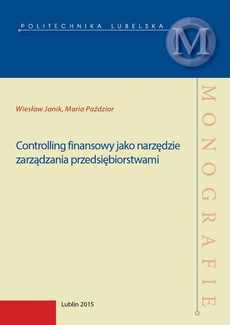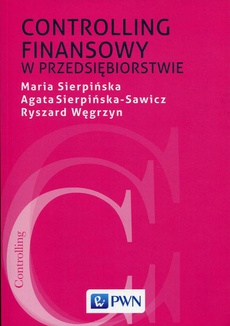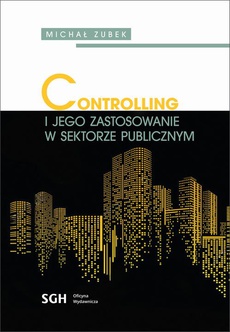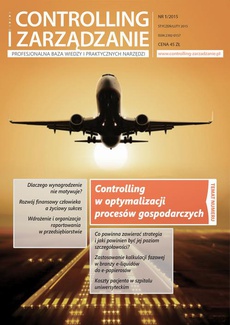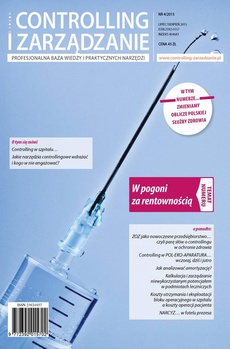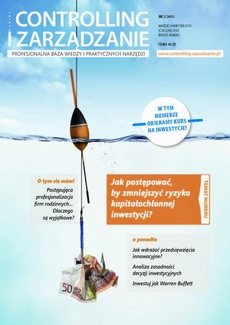POLECAMY
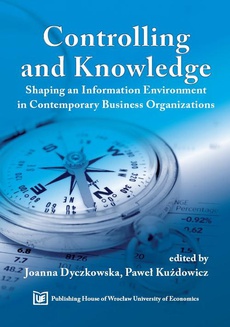
Controlling and Knowledge
Shaping an Information Environment in Contemporary Business Organizations
Redakcja:
Format:
ibuk
The purpose of this monograph is to initiate an academic discussion on knowledge generation process for controlling purposes and the role of controlling in information support for contemporary enterprises. This book also elaborates on the impact of the information flow from the macro environment on business organizations. In order to meet the objective the monograph was divided into three parts.
The first part of the monograph consists of four sections which stress the importance of the knowledge generation process in various areas of research and business, and raise questions about the challenges that management information systems are facing at present. The discussion on knowledge generation process in business organizations implies questions of how knowledge should be defined and how its possession contributes to the enhancement of business potential. Traditional approaches differentiate between data, information and knowledge. Data comprises raw numbers and facts, information represents processed or analyzed data which gains in importance, whereas knowledge embodies applied information supported by experience [Flanagin, Bator, 2011]. Knowledge which is generated, transferred and sustained within an organization emerges due to numerous situated social interactions [Lyon, Chesebro, 2011]. Hayes and Walsham [2003] claim that knowledge is socially implanted and cannot be perceived in isolation from practice. Flanagin and Bator [2011] add that knowledge has a fundamentally communicative nature, since it is both situated in practice and based on problem-solving and thinking. Therefore it cannot be considered as a commodity which is exchanged between individuals. Knowledge sharing is caring about the receivers of messages.
| Rok wydania | 2014 |
|---|---|
| Liczba stron | 182 |
| Kategoria | Zarządzanie, organizacja, strategie |
| Wydawca | Wydawnictwo Uniwersytetu Ekonomicznego we Wrocławiu |
| ISBN-13 | 978-83-7695-414-1 |
| Numer wydania | 1 |
| Język publikacji | polski |
| Informacja o sprzedawcy | ePWN sp. z o.o. |
Ciekawe propozycje
Spis treści
| Preface | 9 |
| Part I. Knowledge Generation Process for Controlling Purposes | 15 |
| Chapter 1. Management Information Systems for Non-Governmental Organisations. The Evidence from Poland (Tomasz DYCZKOWSKI) | 17 |
| 1.1. Introduction | 17 |
| 1.2. Relations of NGOs with their stakeholders and the impact they have on management information systems | 18 |
| 1.3. The information needs of NGOs and the scope of their reflection in obligatory reporting systems in Poland | 21 |
| 1.4. Performance indicators as part of management information systems in NGOs. | 25 |
| 1.5. Developing a management information system in NGOs | 29 |
| 1.6. A structure of an integrated management information system for an NGO | 33 |
| 1.7. The scope of implementing management information systems in Polish NGOs | 37 |
| 1.8. Conclusion | 39 |
| Chapter 2. Tacit Social Knowledge and Modelling of Socio-Technical Systems – an Example of Corporate Social Responsibility in Family Businesses (Günter H. HERTEL, Dennis LOTTER) | 42 |
| 2.1. Introduction | 42 |
| 2.2. Controversial discussion between quantitative and qualitative methods in the theory of economics | 42 |
| 2.2.1. Theory deployment in economics | 43 |
| 2.2.2. Productive way of combining the quantitative and qualitative approach | 46 |
| 2.3. Special investigation of the Corporate Social Responsibility (CSR) as an example for the research design of the Advanced Triangular Method | 47 |
| 2.4. A guideline for the application of the Advanced Triangular Method for other cases | 50 |
| 2.5. Conclusion | 63 |
| Chapter 3. Informational Aspect in Controlling (Wiesław WASILEWSKI) | 66 |
| 3.1. Introduction | 66 |
| 3.2. The essence of controlling | 66 |
| 3.3. Functions and tasks of controlling | 68 |
| 3.3.1. The main tasks of controlling | 68 |
| 3.3.2. Informative viewpoint of controlling | 69 |
| 3.3.3. Rationality and controlling | 72 |
| 3.4. Controlling and quantitative methods in current management theories | 73 |
| 3.5. Conclusions and suggestions on new and modified theoretical analyses | 75 |
| Chapter 4. Potential Future Controllers’ Perception of the Effectiveness of Information Sources on Job Offers. Research Report (Marta NOWAK) | 77 |
| 4.1. Introduction of the research problem | 77 |
| 4.2. Theoretical foundations on perception | 79 |
| 4.3. Empirical research method | 81 |
| 4.4. Analyses of research results | 83 |
| 4.5. Conclusions and recommendations | 86 |
| Part II. Controlling in Information Support for Business Organizations | 89 |
| Chapter 5. Closure of Reporting Period in an Enterprise Using ERP System (Dorota KUŻDOWICZ, Paweł KUŻDOWICZ) | 91 |
| 5.1. Introduction | 91 |
| 5.2. What is the closure of reporting period? | 91 |
| 5.3. Cost accounting systems approach | 92 |
| 5.3.1. Simplified approach of tied-in cost system | 93 |
| 5.3.2. Extended approach of tied-in cost system | 94 |
| 5.3.3. Self-balancing cost accounting in a table format | 95 |
| 5.4. Implementation of the chain of cost accounts in a standard software | 97 |
| 5.4.1. Standalone software or ERP system? | 97 |
| 5.4.2. Data flows within ERP system | 99 |
| 5.4.3. Cost allocation using data flows | 100 |
| 5.5. The empirical case | 100 |
| 5.5.1. Tied-in cost system in Group 4 and 5 accounts | 101 |
| 5.5.2. Self-balancing cost accounting in a table format | 101 |
| 5.6. Conclusion | 103 |
| Chapter 6. The Application of Operational and Strategic Controlling Instruments in the Process of Real Estate (Sławomir KŁOSOWSKI) | 105 |
| 6.1. Introduction | 105 |
| 6.2. The essence of real estate management | 106 |
| 6.3. Controlling and its instruments | 107 |
| 6.4. Possible applications of controlling instruments in real estate management | 109 |
| 6.5. Further research | 110 |
| 6.6. Conclusion | 111 |
| Chapter 7. Project Cost Control Supported by proALPHA® ERP System (Paweł KUŻDOWICZ) | 114 |
| 7.1. Introduction | 114 |
| 7.2. Formulation of a problem | 114 |
| 7.3. Modelling the quantity and value stream flows | 115 |
| 7.3.1. Expected value of cost | 115 |
| 7.3.2. Value stream flows in purchasing processes | 116 |
| 7.4. Project management supported by proALPHA® | 118 |
| 7.4.1. Project structuring and scheduling | 118 |
| 7.4.2. Project cost control | 121 |
| 7.5. Example of the method’s implementation | 123 |
| 7.5.1. Classic approach: plan vs. actual | 123 |
| 7.5.2. Extended approach: plan vs. actual vs. obligation | 124 |
| 7.6. Conclusion | 125 |
| Part III. An Information Macro Environment of Contemporary Business | 127 |
| Chapter 8. Knowledge on Causes of Business Failures in Times of Economic Slowdown. Evidence from the Polish Stock Market in 2012-2013 (Joanna DYCZKOWSKA) | 129 |
| 8.1. Introduction | 129 |
| 8.2. Classification of business failure causes – literature review | 129 |
| 8.3. Statistics concerning bankruptcy declarations on the WSE in 2012-2013 | 136 |
| 8.4. Reasons for business failures in the construction sector using an example of general contractors’ bankruptcies | 138 |
| 8.5. Reasons for business failures in the trade sector using an example of retail chain collapse | 142 |
| 8.6. Conclusion and discussion | 144 |
| Chapter 9. Instruments to Ensure Quality of Services in Shared Services Centres (Marta KAWA) | 150 |
| 9.1. Introduction | 150 |
| 9.2. Instruments to ensure quality | 151 |
| 9.2.1. Process documentation | 151 |
| 9.2.2. Separation of roles and responsibilities | 154 |
| 9.2.3. Service Level Agreements | 154 |
| 9.2.4. Management by goals | 155 |
| 9.2.5. Constant improvement policy | 157 |
| 9.2.6. Kaizen | 158 |
| 9.3. Quality verification | 159 |
| 9.4. Conclusions | 161 |
| Chapter 10. Relationship Between Sovereign Ratings and CDS Prices (Petr BUDINSKÝ) | 163 |
| 10.1. Introduction | 163 |
| 10.2. The research methodology | 164 |
| 10.3. Presentation of results | 166 |
| 10.4. Discussion | 173 |
| 10.5. Conclusion | 175 |
| Notes | 177 |
| List of figures | 179 |
| List of tables | 181 |

















